Featured Past Articles
 By Joseph Muita
By Joseph Muita
Every flower stem counts hence successful farmers are smart to maximize yields through crop protection. Do you?
Downy Mildew is one of the major fungal challenges to the floriculture industry whose control budget is about 20% of the total pesticide value. It occurs rapidly and the effect on the quality of roses is irreversible and the loss is irreparable.
Once it takes hold, it will defoliate a plant very rapidly. While total defoliation does not immediately kill a plant as would, say, an accidental application of an herbicide, its loss of photosynthesizing ability stresses and weakens the plant to a degree that it becomes totally unproductive, a situation from which it may never recover. Downy is extremely contagious and will spread throughout your rose garden quickly if left untreated, laying waste to all the plants within a very short time.
Botrytis is also an important disease commonly known as Grey Mold which changes during its life cycle from being saprophytic to parasitic and acknowledged for considerably reducing marketable quality of roses. Botrytis has high potential of developing resistance as a result of indecorous usage of pesticides.
Read more: Botrytis And Downy Mildew Malady: Liberate Your Rose Crop
 KLM, Royal FloraHolland, and Amsterdam Airport Schiphol are reinforcing the air bridge between Kenya and the Netherlands, joining forces to ensure that the Aalsmeer-Schiphol region remains the world’s top flower-trading centre.
KLM, Royal FloraHolland, and Amsterdam Airport Schiphol are reinforcing the air bridge between Kenya and the Netherlands, joining forces to ensure that the Aalsmeer-Schiphol region remains the world’s top flower-trading centre.
The goal of the Holland Flower Alliance (HFA) is to realise a seamless chain that will ensure the highest product quality and fastest transport times in the most cost-efficient way. The Alliance is currently focusing on Schiphol’s most significant flower-importing country: Kenya.
Marcel Claessen, Chief Operating Officer at Royal FloraHolland, recognises the vital importance of a seamless flower chain. “Our business is becoming increasingly global. Products are travelling ever-greater distances to arrive in the Netherlands, with the distribution areas becoming increasingly diffuse. Europe and its neighbouring countries used to be our primary market, but now markets further afield are growing in importance.
“If we want to ensure that Dutch growers and export companies maintain their leading role in the future, we will need to participate in the right initiatives – such as this cooperation.”
Extending vase life
The EVP of KLM Cargo, Marcel de Nooijer, explains: “The aspect known as ‘vase life’ is crucial to the rose trade. From the moment the product begins its journey to the customer, time and temperature are the components that will determine the product’s value. The more effectively organised the chain is, the longer the vase life will be – and the higher the value.’ To achieve this goal, the three partners are focusing on two key areas for improvement:
Defining and setting up the ideal chain. The various logistical links must flow seamlessly into one another. The HFA aims to define the ideal chain, from the grower in Kenya to the flower auction in Aalsmeer. In particular, measures to improve the cool chain will be examined, along with ways to standardise flower packaging.
IT integration via an independent data platform to which all players in the chain are connected. Through this platform, the parties can keep one another informed and access information. Everyone will have insight into the status of each shipment. This will allow all links in the chain to arrange their logistics processes more effectively, while also reducing waiting times.
Real-time monitoring
Supporting the efforts is FlowerWatch, working from its offices in the Netherlands, Kenya, and Japan to take the lead in quality control. The chains are monitored using temperature data loggers, as it is important to be able to analyse the chain retrospectively.
When you have real-time certainty that the cooling units throughout the entire chain are working properly, it means you can be sure that partners are living up to their promises – each and every day.
Together, three businesses with Dutch roots – Bexter in the Netherlands and Upande, and FlowerWatch in Kenya – have rolled out a real-time monitoring network that offers insight into the performance of the cool chain at all times.
Toon de Jong, co-owner of Bexter, designed the online platform with his team and is currently expanding the network at the European end of the chain.
Mark de Blois, CEO of Upande, supplies and maintains the hardware and works on new sensors.
Jeroen van der Hulst from FlowerWatch works to achieve optimal performance in the flower chains.
Preparation phase completed
Although the development of new technology offers huge opportunity in a rapidly-growing economy such as Kenya’s, it also provides a number of challenges. Now that the preparation phase has been completed, the three partners are looking to the future with confidence. Mark de Blois, CEO of Upande in Kenya says, “Today, thanks to the online integration of countless sensors, Flower Watch is in a position to allow its customers to take decisions based on real-time data. In terms of the potential of these developments, what we’re seeing now is just the tip of the iceberg.” Jeroen van der Hulst predicts, “In just fifteen years, the flower industry has become globalised. While the Netherlands is still the physical hub of the trade, the networks outside of the Netherlands are growing rapidly. This is our chance to help the business mature – it’s no longer about being the first one to tap a new market or introduce a new cultivar. Today, it’s about making our chains operate more efficiently than others.”
Flower transport by sea
Each day, millions of cut flowers – mostly roses from Kenya – are transported to the Netherlands by air. Travel by sea freight would reduce the CO2 footprint of each rose considerably, and it would be cheaper as well. Anton Bril (VGB) explains the drawback, “The challenge is keeping the flowers fresh for three weeks during transport, so that the vase life on the consumer side doesn’t suffer.”
In March, research partners VGB and Wageningen UR wrapped up the GreenCHAINge project. During the project, four sea freight journeys were carried out and a new sea freight protocol for roses was developed. The primary focus was on improvements that could lead to a decrease in post-harvest losses.
This partnership between commercial parties and research centres Royal FloraHolland, Wageningen UR, Flora Life, Chrysal, and Flower Watch was unique and allowed for the development and testing of a comprehensive protocol for the entire sector.
Feasible protocol
The protocol is based on two principles: high quality and feasibility.
By ensuring the correct preparation and a proper cool chain at the start of transport, the quality of the roses is suitable for ocean freight.
The protocol has been designed in such a way that rose growers can comply with it without the help of an adviser.
An ocean freight box with standard dimensions has been developed in addition to the protocol. This standard freight box has been designed for optimal loading into a 40-foot reefer container. A matrix for the loading ratio has also been established, so that the trader knows exactly how many roses should go in a box for ideal loading. The effects of ventilation holes, bags and liners have also been tested in order to find the right balance in the microclimate to prevent the fungal infection Botrytis cinerea whilst also avoiding dehydration of the roses.
The last container was exposed to freezing temperatures, meaning that these are all the clear conclusions on what constitutes ‘ideal packaging’ we have for now.
For the sixth year in a row, Kenya is set to host the International Flower Trade Expo (IFTEX), slated for June 7-9 at the Oshwal Centre, Parklands, Nairobi.
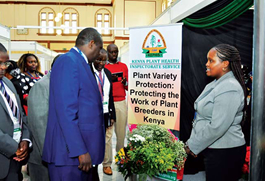 Currently, IFTEX is at par with other important flower exhibitions organized by HPP which include World Floral Expo (USA), Agriflor (Quito, Ecuador), and the International Floriculture Trade Fair (Vijfhuizen, Holland), all that are key activities in the flower industry calendar. Since IFTEX opened its doors here in 2012, there has been a steady pattern of target visitors. Kenya’s flowers are a sensation in the US going by the interest the Kenya pavilion attracted during the World Floral Expo in Las Vegas (US) held early this year. This year’s show comes amidst renewed focus in the country following the classification of JKIA to Category A status enabling direct flights to the US from Nairobi. The two make US the main target this year.
Currently, IFTEX is at par with other important flower exhibitions organized by HPP which include World Floral Expo (USA), Agriflor (Quito, Ecuador), and the International Floriculture Trade Fair (Vijfhuizen, Holland), all that are key activities in the flower industry calendar. Since IFTEX opened its doors here in 2012, there has been a steady pattern of target visitors. Kenya’s flowers are a sensation in the US going by the interest the Kenya pavilion attracted during the World Floral Expo in Las Vegas (US) held early this year. This year’s show comes amidst renewed focus in the country following the classification of JKIA to Category A status enabling direct flights to the US from Nairobi. The two make US the main target this year.
It has been costly and lengthy to ship the country’s flowers to the world’s biggest market after the EU. “Owing to the availability of the flights, we expect more American buyers in Nairobi next month going by confirmed visits and increasing inquiries”, says Dick Van Raamsdonk. Nobody can deny the fact that in this year’s show the catchphrase will be, “Buyers from America’’.
Read more: IFTEX: Ensuring Market Consolidation and Diversity
Bellissima’s exclusive assortment of roses have large flower-heads of average 6cm and long sturdy stems of average 80cm – 100cm.
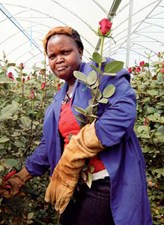 Mt Kenya, Africa’s second highest peak, forms an imposing background while majestically staring down at the idyllic expanse of Timau near Nanyuki in Kenya. It is amidst this picturesque setting that Chui Farm, the newest venture by AAA Growers is located. Chui Farm produces some of the most exclusive and exceptional Kenyan roses under the brand name Bellissima; which fittingly translates to “Gorgeous Lady” in Italian.
Mt Kenya, Africa’s second highest peak, forms an imposing background while majestically staring down at the idyllic expanse of Timau near Nanyuki in Kenya. It is amidst this picturesque setting that Chui Farm, the newest venture by AAA Growers is located. Chui Farm produces some of the most exclusive and exceptional Kenyan roses under the brand name Bellissima; which fittingly translates to “Gorgeous Lady” in Italian.
Bellisssima premium Kenyan roses are unpacked and sold through auction in Europe by Flower Optimal Connection and direct sales to other parts of the world. Flower Optimal has many years experience offering strategic solutions and efficient unpacking services to growers from Kenya, Ethiopia, Israel and other countries. The farm currently has 20 hectares under production with a further 10 hectare expansion under development and projected to be operational before the close of 2017.
Read more: The Success Story of AAA Roses Premium Kenyan Roses
Mt. Kenya region is extremely scenic with the escarpment giving way to dramatic wooded gorges and tangled riverine thickets. Behind the scenery flower farming is a big business. Maurice Koome Writes.
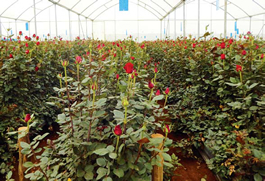 Due to the diverse range of habitats, Laikipia hosts an abundance of wildlife, second only to the Masai Mara in Kenya. It has significant populations of predators and also the “big five”, with over 50% of Kenya’s Black and White Rhinos, thousands of elephants, about 25% of the world’s Grevy Zebras, and an increasing population of Wild Dogs. The focus of wildlife viewing here is in Lewa Wildlife Conservancy.
Due to the diverse range of habitats, Laikipia hosts an abundance of wildlife, second only to the Masai Mara in Kenya. It has significant populations of predators and also the “big five”, with over 50% of Kenya’s Black and White Rhinos, thousands of elephants, about 25% of the world’s Grevy Zebras, and an increasing population of Wild Dogs. The focus of wildlife viewing here is in Lewa Wildlife Conservancy.
More than great Scenery
When I first met Mr. Kanyingi, Editor Floriculture Magazine in one of our product launches at a Nanyuki Hotel, he was full of lamentations. “Mt. Kenya is more than Snowy Mountain”, I answered. “Yes I know, it is the most accessible, and popular with Johnnies. The Timau and Nanyuki triangle is characterised by diverse landscapes, rolling hills interrupted by rocky outcrops intricately merged into beautiful scenery reminiscent of a canvas painting.
REGIONAL BRIEFS
Kenya Airways prepare for direct flight to us
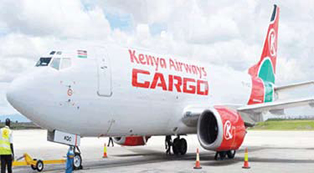 Kenya’s fresh produce growers have something to smile of. Kenyan airways are expected to start making direct flights to the United States, after the US Federal Aviation Administration issued Kenya with a certificate of security and safety clearance.
Kenya’s fresh produce growers have something to smile of. Kenyan airways are expected to start making direct flights to the United States, after the US Federal Aviation Administration issued Kenya with a certificate of security and safety clearance.
The clearance follows a successful audit of the Jomo Kenyatta International Airport (JKIA), the largest airport in Kenya, by the International Civil Aviation Organization to determine if it meets the necessary international standards.
The announcement was made by Kenya’s Cabinet Secretary for Transport, James Macharia, who called on Kenya Airways, Kenya’s national carrier, to “immediately apply for approval to codeshare with US airlines while concurrently pursuing approval for direct flights.”
Welcoming the safety clearance, Kenya’s Cabinet Secretary for Treasury, Henry Rotich, said direct flights between Kenya and the United States will have a favorable impact on Kenya’s tourism and business sectors.
Flower growers interviewed by Floriculture welcomed the clearance. “The US market is big and we expect to benefit from it”, said a grower. Adding, “We have been selling uncompetitively due to high freight charges.
Direct flights will reduce this”. Kenyan flowers have been going through Europe or South Africa to get to the US market. This has made them less competitive compared to South Americans which are next door.
Speaking exclusively to Floriculture, Ms Jane Ngige, the CEO Kenya Flower Council said Kenya’s flower production quality and audit standards are the best in the world and therefore they may not face any serious competition. However she said more market study was needed to establish the type of varieties the US Market needs. The Kenyan government has welcomed the security approval by the United States, saying it is a result of sustained cooperation between the two countries in many areas, such as security, exports, imports, and tourism.
For its part, Kenya Airways has welcomed the security clearance, saying it is ready to “immediately” start flying passengers directly to the United States.
The airline’s outgoing CEO Mbuvi Ngunze said their priority is to pursue codeshare arrangements with their partners in the Skyteam Alliance to make sure they begin direct flights to the United States soonest.
GLOBAL BRIEFS
‘Kenyan roses not replacing those from South America’
Roses with long stems, large head sizes and a good quality. In Russia, this is how they used to describe a rose. However, their perception and requirements regarding roses changed when Kenyan roses with intermediate head sizes entered the market. Partly due to the crisis, the demand for these types of roses increased; Since January 2016, volumes to Russia and former soviet countries have increased six fold.
Intermediate head sizes
Russians used to go for South American roses, the ones with long stems, large head sizes and good quality. However, the demand for Kenyan roses and roses with intermediate head sizes in particular increased sharply. “Kenya also produces large head roses, but often cannot meet the quality of these South American roses. Quality is a major requirement for the Russian buyers, but due to the crisis, prices became an important requirement too. And the intermediate head sized roses combine both; they have good quality and can be supplied for lower prices. And the same goes for the Kenyan spray roses. These types of roses are also well demanded.
Different position
As these Kenyan roses are cheaper and have high quality, will they overtake the position of the South American roses? According to experts, they will not. “The Kenyan roses are used for different purposes. They are, for example, often used by florists to make the ‘cheaper’ compositions and by flower shop owners to attract buyers. They are promoting the Kenyan flowers on a sign outside their shop. These rose prices are lower than the rose prices that people are used to. It makes them curious.
Trend to continue in 2017
For 2017, growers expect the positive trend of 2016 to continue. “We expect to increase our volumes to Russia and to explore new markets in Russia. Besides that, we would like to discover new markets in the former Soviet countries like Kazakhstan, Belarus, Moldova and Kyrgyzstan”, says a grower.
Kisima introduces new Bi-color rose No Limit
Kisima launched No Limit at Royal FloraHolland in Aalsmeer. Kisima plants this variety in Timau and will supply length of 40 till 70 cm. Fresco Flowers - located in Aalsmeer- will take care of the unpacking, control and sales of No Limit. No Limit has a beautiful striking pink/white color combination.
No Limit has a strong vase life, good transportability and unique presentation during sales and in the vase. No Limit is developed by Select Breeding. Select Breeding is specialized in the development of medium and T-hybrid cut roses.
Women’s Day: Shorter stem roses
Colored roses with shorter stems of 35 and 40cm with a head size of 4 to 4.5 cm were the most demanded flowers in this year’s Women’s Day in Russia. Since February 21, many Kenyan rose farms were busy with their Women’s Day shipments.
It is considered to be the biggest day for flower sellers in Russia, so the demand for flowers, and in particular roses, is always high, which means good prices for many growers.
Even though the financial situation in Russia seems to be improving, people are still looking for the more affordable options. “They used to buy the large stem roses before the crises, but now they seem to prefer the shorter stems. Besides that, there is also an increase in demand for the spray roses this year.
United Selections holds annual open days in Ethiopia
On Thursday 2nd of March and Friday 3rd of March 2017, United Selections had their annual open days at Joytech, Ethiopia. They show cased a new range of varieties on the two days. The showhouse ready and on flush. Growers were warmly welcomed to learn more about the new assortment for the Ethiopian market! Going by previous years, the breeder was happy with the attendance and hoped this will turn into a conversion.
GLOBAL BRIEFS FloralHolland to open new facilities in China This year, Royal FloraHolland, the leading Dutch floral cooperative formed in 1911, will open new facilities in Guangzhou and Beijing.
This year, Royal FloraHolland, the leading Dutch floral cooperative formed in 1911, will open new facilities in Guangzhou and Beijing.
Its trade mission to Shanghai in 2015 spawned strong new links with the Chinese cut flower industry, and led to the creation of the first facility close to Pudong International Airport in Shanghai in 2016.
Royal FloraHolland’s newest facility in Guangzhou will be its most important move in China to date. Guangzhou’s direct connection to Nairobi will allow flowers from Kenya to be delivered straight to China, resulting in a shorter cool chain line and faster delivery for world-class flowers.
“It is our goal to deliver quality,” stressed Lucas Vos, CEO of Royal FloraHolland, “with Chinese-grown flowers combined with internationally grown flora.”
“We thoroughly enjoy working with China because the country has a rich tradition of gifting and festivals,” said Guido de Wit, program director of the Amsterdam-based World Flower Exchange. “Our Chinese customers recognize a rich range of symbolism and meanings associated with different flowers.”
“It challenges us to be aware of multicultural differences, so we can meet the demand for flowers together with our Chinese partners,” he continued. “We also receive a tremendous number of online reviews from our customers in China, who appreciate our commitment to quality and beautiful big headed flowers.”
Royal FloraHolland boasts on-time delivery as well as a seven-day guarantee for customers. With the response from the Chinese market and satisfied clients, it fully expects its business in China to continue to bloom.
Rwanda seeks to increase flower exports
A narrow export base and Ad eclining volumes, coupled with the widening trade deficit driven by the mismatch between import bills and export receipts, have been one of the biggest challenges for Rwandan government strategists and the private sector.
With the international commodity prices dropping and the continued poor performance of the global economy, Rwanda’s traditional markets in Europe, China and America scaled down on imports, hurting the country’s export receipts.
The government and private sector players have over the past two years been working more closely to find ways of improving the country’s exports and reduce the import bill. There are so far many initiatives that are already in place to achieve this, export promotion and diversification.
Under the export diversification strategy, flower growing has been identified as one of the areas that can help the government achieve its target in a short time.
Already, the country’s flagship project, Gishari Flower Park in Rwamagana, could start flower exports. NAEB’s Bella Flowers kicked off raising hopes that the sector could boost exports in 2017. Bloom Hills Rwanda, a Japanese flower export firm based in Musanze District, has also started flower exports. The sector earned $56 million during the first 10 months of 2016, according to NAEB statistics
Valentine with Interplant: Simplicity at its best!
During Valentine, it’s rush hour for all our beloved rose growers worldwide. It’s the time of the year where millions of roses are being sold when lovers take the opportunity to express their feelings to one another! Interplant has many varieties suited for Valentine Bouquets, however, this year we chose to show you Simplictiy at its Best! customers enjoyed our lovely hybrid-tea variety Explorer, an absolute star amongst red rose varieties and rapidly conquering the world at the moment.
ONE NAME. ONE VISION. ONE BOOTH.
The complete Dümmen Orange Portfolio served together first time on one booth in hall 2. The team was happy to tour customers through the world of Pot Plants, Annuals, Perennial, Cutflowers, Succulent and Bulbs and enjoyed to have a nice Coffee together with growers.
Royal De Ruiter launches ‘The Big Five’ promotion campaign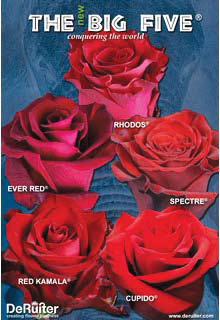 The Big Five®. You might think of the five most beautiful African animals first, but now, it also represents the top red rose varieties of Royal De Ruiter. In their so-called ‘The (new) Big Five’ campaign, Royal De Ruiter promotes their five best red rose varieties; Rhodos, Ever Red, Spectre, Red Kamala and the most recent introduction Cupido. These are being produced in De Ruiter’s production areas in South America, Africa and Europe. “The relevance from a marketing perspective is awesome”, says Örjan Hulshof Sales and Marketing Manager of the company. “The campaign supports growers, traders and florists who are dealing with these varieties during the Valentine’s period, but also for the longterm
The Big Five®. You might think of the five most beautiful African animals first, but now, it also represents the top red rose varieties of Royal De Ruiter. In their so-called ‘The (new) Big Five’ campaign, Royal De Ruiter promotes their five best red rose varieties; Rhodos, Ever Red, Spectre, Red Kamala and the most recent introduction Cupido. These are being produced in De Ruiter’s production areas in South America, Africa and Europe. “The relevance from a marketing perspective is awesome”, says Örjan Hulshof Sales and Marketing Manager of the company. “The campaign supports growers, traders and florists who are dealing with these varieties during the Valentine’s period, but also for the longterm
Beautiful new numbers by Kordes Roses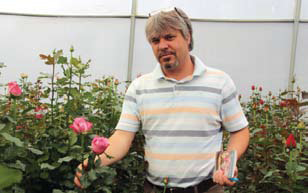 Rose growers from across the East African region are naturally clamoring for new interesting varieties to include in their production lines. Kordes Roses’ new codes have drawn a lot of interest from growers. Most have visited their Naivasha farm recently and discussed some of the varieties that are quite promising. These varieties have been the most popular in trial selections inline with indications that growers are looking for larger head sizes without compromising on production.
Rose growers from across the East African region are naturally clamoring for new interesting varieties to include in their production lines. Kordes Roses’ new codes have drawn a lot of interest from growers. Most have visited their Naivasha farm recently and discussed some of the varieties that are quite promising. These varieties have been the most popular in trial selections inline with indications that growers are looking for larger head sizes without compromising on production.
Commercial testing of new varieties in East Africa is facilitated at ‘Kreative Roses’, the Kordes production company at Naivasha. There, new variety selections are planted in commercial trials in order to prove technical characteristics and market potential, offering customers reliable information as a basis for new variety decisions.
‘I love you’, ‘I care for you’, or simply—’you are a great friend’.
Valentine’s Day is the perfect occasion to show your partner, family or friend just how special they are. Flowers have a long history of being the ideal gift whether you are celebrating 30 years of marriage, have just started to date someone or want to show your friend you appreciate them.
“The beauty of flowers as a Valentine’s Day gift is that they can easily be personalized depending on how you want to make someone feel” said Dejan Kristan, marketing director at Flowers Canada (Ontario). “You want to send out the right message to your Valentine, whether it is ‘I love you’, ‘I care for you’, or simply—’you are a great friend’”.
Red: Undoubtedly the colour of passion. Giving out a red flower arrangement will communicate your strong and powerful love. With a colour the same as the heart, red means seduction, desire and passion. Try red roses, red gerbera daisies or red tulips.
Valentine’s Day breaks records Again
Valentine’s Day is celebrated in many countries and is an important holiday for the flower industry. For weeks, growers, importers, cargo agencies and auctions were busy delivering the flowers on time at their destination.
In the US, billions of flowers were flown into the country and most arrived in Miami from Colombia, Ecuador, Mexico and the Netherlands. More than 90 percent of imported flowers move through Miami International Airport.
Also Kenya exported many flowers this year and even exported a record number of roses to Australia this Valentine’s Day. ABC News reported that figures from the Federal Department of Agriculture show that Australia imported more than 9 million rose stems this month, with the majority sourced from Kenya. In February, more than 5.22 million rose stems were imported from Kenya, up by nearly 850,000 roses in the same period last year. It is understood to be a record for the Kenyan rose trade to Australia
Valentine’s Day 2017: More or less sales?
Since 2014, Valentine was finally celebrated on a weekday; a Tuesday. This provokes the question: was it profitable for the flower business or not? Generally, it can be noticed that many flower importers and florists were positive about this.
High expectations
The demand for Isreali Rusci a Colombian grower; Valentine’s Days on a weekday are often advantageous for people in the flower industry. “It often results in better sales”, he says. Kenyan rose grower Peter Viljoen of Sunland Roses, who exports roses all over the world, adds: “I think that people, and men in particular, are probably more on the street on a weekday and then more easily pass by and enter a flower shop.”
Also the Australia cut flower and foliage industry is excited about this year’s Valentine’s Day.
High prices
And the high demand led to high prices and this is visible at the Dutch FloraHolland auction. On the preceeding Friday, the auction’s CEO, Lucas Vos announced a record price for the Red Naomi rose at the auction. He posted the following message on Twitter: “Today, Red Naomi sold for 5,95 euro. How much will it be in retail?”
Valentine’s Day 2017: facts and figures
Valentine’s Day, the turnover was € 142 million. This is the highest turnover ever recorded in the history of Royal FloraHolland. FloraMondo also realised a new turnover record. Almost €6 million were traded via FloraMondo. Valentine’s Day is more a flower event than a plant event. The flower turnover was almost €100 million, the highest ever turnover for flowers in one week. Turnover grew by 9% compared with week 6 in 2016. The number of items declined by 5%, while the average price rose by 15%.
300 million stems
Of the total supply of 300 million stems of cut flowers, one-third consisted of roses, onethird of tulips and one-third for the rest of the assortment. The supply of tulips and roses was under pressure: the supply of roses decreased by 8%, the supply of tulips by 11%. The majority of the roses came from abroad, only 20% of the total supply of roses came from the Netherlands.
Germany: “Valentine’s Day becomes more colorful”
In the run-up to Valentine’s Day, cold, snow and ice hampered the buying mood of retailers in some regions in Germany, auction prices for the red roses were high - till the Monday before the holiday and the expectations of the wholesalers were low. Flower wholesalers that placed pre-orders seemed to partly profit from their preliminary planning.
This, in a nutshell, was revealed by a survey conducted by the Association of the German Flower Wholesale and Import Trade (BGI), a national interest group of the German cut flower and pot plant wholesalers and import dealers, among its members.
Demand for spring products
“This time neither the weather nor the carnival or a volcanic eruption has crossed our way,” a wholesaler in South Germany told the GBI. According to the traders, the fact that Valentine’s Day fell on a weekday encouraged consumers not only to buy flowers for private use, but also as an appreciation to employees and colleagues. In the west and in the center of Germany, the wholesalers noticed a high demand for the red rose, despite the high prices. However, this year’s Valentine’s day was “more colorful”. All in all, the wholesalers realized that the Valentine’s purchases were focusing strongly on cut flowers this year, but some retailers also reported the first sales of outdoor products for the spring garden. Room plants seemed to be less in demand this year.
All in all we had a good Valentine period
Some growers said that all the work related to Valentine’s Day had already been done by the beginning of week 6.
Ethipia: Affected by weather Unfortunately, reports from Ethiopia weren’t as positive. Production over there has been bad because of the long period of low temperatures.
“Up until four weeks to, the higher altitude areas were still getting quite a few frosty mornings. There were lots of blind shoots, there were only few roses to cut, but the prices were good. It’s hard these days to meet the demand and we’ve even had to buy additional supply. All in all, it was good.
Kenya: Good Valentine
At the moment, there was no shortage at all in Kenya. They had good weather and supply was as expected.
“We cut everything back last November, hoping to get a good flush of Red Naomi. I’m happy to say that our expectations were met.
We ended up with good quantities, both for the auction clock and for our direct customers. Prices and quality were all good. Last year was a bit disappointing, but not this time around,” said a grower.
Timaflor’s Simon van der Burg confirmed that each year is different. Supply at the auctions wasn’t excessive and still, the prices weren’t great. Red was the only colour that was sold at prices similar to last year. Everything else was 5 to 10 cents cheaper.
“Valentine day prices suddenly went up by 4 to 6 cents. Purchases were made more and more at the last minute, so prices went up in the last couple of days.”
Van der Burg has noticed that Kenyan growers say their production has gone down. “But there have been more charter flights than ever before. So all in all, it a good Valentine period.”


